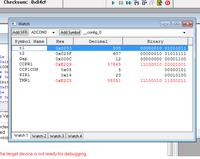Neyolight
Full Member level 5

Hi all
Im trying to use CCP module and timer 1 to capture frequency at RC2.
From the PIC18f4620 spec:
Capture Mode
In Capture mode, CCPRxH:CCPRxL captures the 16-bit value of the TMR1 register when an
event occurs on pin CCPx. An event is defined as:
• Every falling edge
• Every rising edge
• Every 4th rising edge
• Every 16th rising edge
But when I debug my code, I see CCPR1H and CCPR1L incrementing with Timer 1. What could I be doing wrong?
Im trying to use CCP module and timer 1 to capture frequency at RC2.
From the PIC18f4620 spec:
Capture Mode
In Capture mode, CCPRxH:CCPRxL captures the 16-bit value of the TMR1 register when an
event occurs on pin CCPx. An event is defined as:
• Every falling edge
• Every rising edge
• Every 4th rising edge
• Every 16th rising edge
But when I debug my code, I see CCPR1H and CCPR1L incrementing with Timer 1. What could I be doing wrong?



